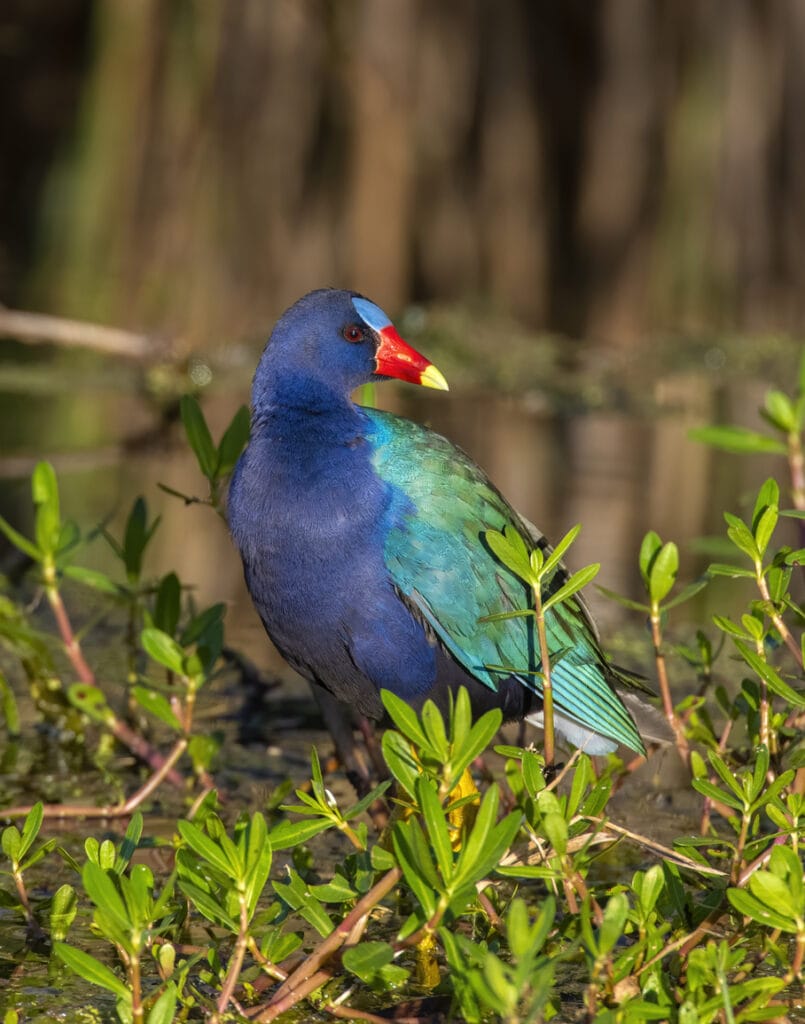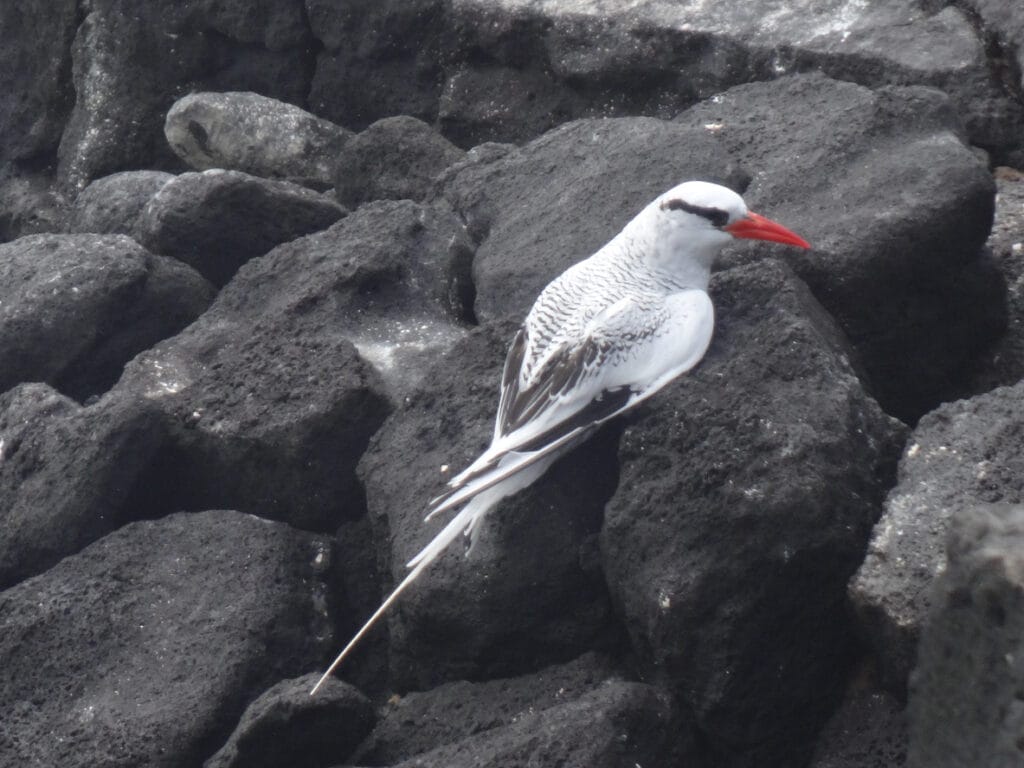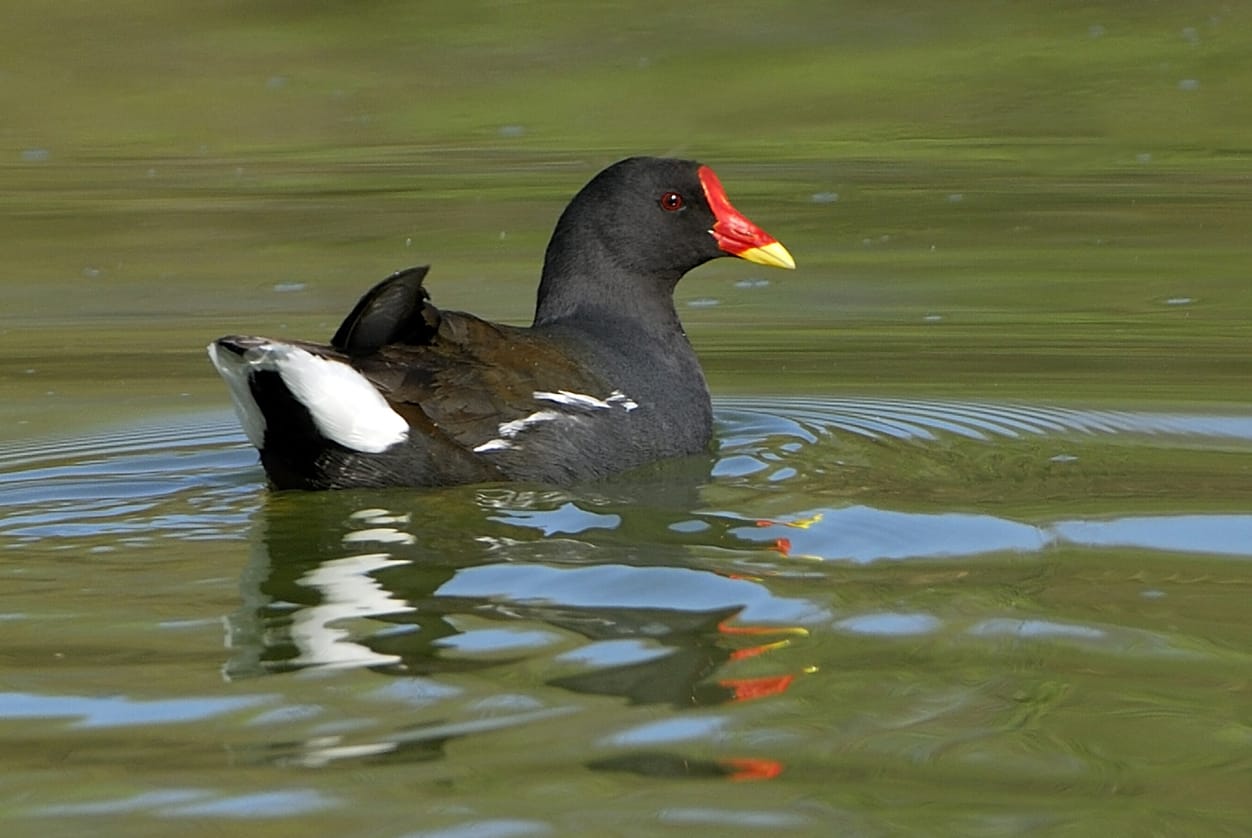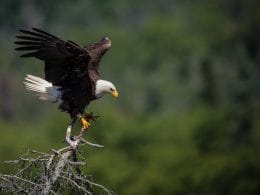One of the easiest features in bird identification is a red beak. It’s such a simple characteristic, but it makes the bird stand out from the crowd.
In this post, we go over 17 dazzling birds with red beaks, from the tiny hummingbird to the plump ducks.
The Beauty of Birds with Red Beaks
In most cases, the red beaks are contrasted with muted plumage, but that doesn’t mean that you can’t find extravagant and colorful birds.
Let’s take a look:
1. Broad-Billed Hummingbird

- Scientific name: Cynanthus latirostris
- Wingspan: 5.1 in
- Length: 3-4 in
- Weight: 0.15 oz
Much like the smaller Green Hummingbird, the broad-billed variety has a sharp red beak that looks out of proportion with its tiny body.
Author Note: In the southern parts of the U.S, you can identify this bird from other hummingbirds with its emerald plumage and glittered throat.
To attract this beauty to your backyard, make sure you have nectar-rich flowers. Don’t let these bodies fool you. With its small red beak, the hummingbird can suck up more than 1.5 times its own body weight in nectar in a single day!
2. Common Moorhen

- Scientific name: Gallinula chloropus
- Wingspan: 23 in
- Length: 12-25 in
- Weight: 12 oz
Think of the moorhen as a chicken that lives near fresh or brackish water bodies to look for prey. After all, it’s called the waterhen and the swamp chicken for a reason!
Moorhens are some of the most common birds in the countryside all over the world. They can be identified with a glossy red beak that starts high on their head and ends with a sharp golden yellow tip.
This beak is what sets it apart from the coots, but it’s almost identical to that of the Purple Gallinule.
3. Purple Gallinule

- Scientific name: Porphyrio martinicus
- Wingspan: 22 in
- Length: 20 in
- Weight: 7.2-10.3 oz
If you look at the bland and buff-colored juvenile gallinules, you never would imagine that they would turn out to be colorful birds!
Once they grow up, they start flaunting their fluorescent green wings, shiny purple underparts, and the red beak with the yellow tip.
Purple Gallinules are more common across Central and South America, but they can still be spotted in Florida all year round.
4. Chough

- Scientific name: Pyrrhocorax pyrrhocorax
- Wingspan: 29-35 in
- Length: 15-16 in
- Weight: 10.5 oz
The Chough has the typical black plumage of the crow family. However, its bright red feet and beak set it apart from other varieties. In fact, the bird is also called the “red-legged jackdaw” in Ireland.
Top Tip: In Europe and Asia, the choughs prefer rocky west coasts where it soars and swoops for exercise more than for hunting. They even like flying upside down and doing acrobatic-like barrel rolls!
It’s often spotted ranging with other dark corvid birds from crows to jackdaws. The flock’s cawing will be too loud for you not to turn around and enjoy the view!
5. Green Magpie

- Scientific name: Cissa chinensis
- Wingspan: 37 in
- Length: 15 in
- Weight: 4.5 oz
With a neon body, latticed wings, black eye shading, and bubbly personality, the shiny dark red beak is only the tip of what makes the Green Magpie interesting.
The young chicks are almost always born blue. However, they change into this apple-green plumage as they grow into adulthood.
In the wild, it’s naive to the Himalayas region, but it’s not uncommon to find in large zoos. If you get a chance to see the Green Magpie up close, odds are you’ll never forget its appearance or its harsh chirping!
6. Inca Tern

- Scientific name: Larosterna Inca
- Wingspan: 31 in
- Length: 16 in
- Weight: 7 oz
Red beaks are no stranger to the terns, from the Caspian to the arctic varieties. However, what sets the Inca Tern apart is its mustache.
From the dark gray plumage, both the pointed red beak and the white mustache-like plumage pop and give this bird its unmistakable identification.
Besides ornamental reasons, scientists believe that the length of the white plumage is an indicator of the bird’s overall health.
7. St. Helena Waxbills

- Scientific name: Estrilda astrild
- Wingspan: 4.5 in
- Length: 4-5 in
- Weight: 0.75 oz
If you look at the St. Helena Waxbill from the side, the small red beak looks like it’s an extension of the red stripe around their eyes. From a distance, it almost looks like a fiery flame across the bird’s head.
They’re also known for their white neck that fades into a red striped belly. Otherwise, their bodies are mostly muted gray or brown with dark legs.
Author Note: A Black-rumped variation of the Common Waxbill lacks the red belly and gains solid black tail feathers. Both are very mild-tempered tropical birds with a low bubbling song that can vary from one bird to the other.
8. American White Ibis

- Scientific name: Eudocimus albus
- Wingspan: 38 in
- Length: 22 in
- Weight: 33 oz
Unlike its Australian Black-beaked counterpart, the American White Ibis is red from the face and up to the middle of its beak. The tips are often a bit faded in color, and it either turns black or buff.
Once this fierce-looking wader gets out of the water, you’ll spot its glossy legs that perfectly match the red face and beak. The legs lose their brightness and turn into a muted pink hue during their breeding, though.
You can spot all the birds all year round on both the eastern and western coasts of Central America. It also makes its way up to Florida, Louisiana, and South Carolina. Look for them inland during their breeding and nesting seasons.
9. Northern Cardinal

- Scientific name: Cardinalis cardinalis
- Wingspan: 10-12 in
- Length: 8-9 in
- Weight: 1.5 oz
Speaking of common birds with red beaks, we can’t leave the blood-shot Northern Cardinal unmentioned.
The wide red beak comes from a black base on the bird’s face. Which Is probably the most obvious deviation from the all-red scheme. Its crest, neck, chest, and belly are all red. The wings are a bit darker, but they still blend in.
Author Note: The species is mainly spread over the northern parts of the U.S and Canada, but its distribution is more focused on the eastern regions. The red bird population tends to be rare west of the great plains.
10. Laughing Gull

- Scientific name: Leucophaeus atricilla
- Wingspan: 41 in
- Length: 13 in
- Weight: 9.8 oz
Laughing Gulls are slender-looking birds with a strident call and a soft spot for warm lands near water bodies.
The key identification features here are the bright red beak and the crisp line that separates the white neck from the black head. Plus, their eyes look like they’re sandwiched between two white lines.
Usually, the gulls prefer coastal regions, but if you live in Florida, you have a higher chance of seeing the birds inland.
11. Long-tailed Finch

- Scientific name: Poephila acuticauda
- Wingspan: 8-10 in
- Length: 5-6 in
- Weight: 0.4-0.6 oz
The Long-tailed Finch is an Australian gray bird whose head looks very comical with one sharp circle of black that looks somewhere between a bib and an eye mask. The black spot leads to a tiny triangular orange-red beak.
However, males have more vivid beak colorations. They’re also larger and have a wider black bib spot than the females.
The birds are common on the northern coast of Australia, and they’re pretty active and friendly. They’re also known for their head bobbing. These bubbly little finches are quite entertaining to watch!
12. Black Oystercatcher

- Scientific name: Haematopus bachmani
- Wingspan: 28-36 in
- Length: 16.5-18.5 in
- Weight: 19.4 oz
As the name suggests, the Black Oystercatcher is a dark-colored shorebird that feeds on marine life, including mussels, shellfish, urchins, and limpets.
While it’s not a solid black, the dark plumage has brown and gray shades that help the bird blend into rocky backgrounds. You can see this color scheme in southern California, Seattle, and Baja.
Top Tip: The dark plumage makes the bright orange-red beak with a yellowish tip even more distinctive. It also happens to match the bird’s eye perfectly!
Along its red beak, the bird has a faded flesh-toned red that looks like it’s translucent and shows the blood underneath. The genus name “Haematopus” is actually Greek for blood-footed!
13. Stork-Billed Kingfisher

- Scientific name: Pelargopsis capensis
- Wingspan: —
- Length: 14 in
- Weight: 5-7.7 oz
The south Asian Stork-billed Kingfisher is so magical-looking that it almost feels unrealistic. For one, its plumage takes a sharp turn from the yellow underparts to a bright teal blue wing.
On top, the bird has a brown helmet-like spot that breaks the contrast between the yellow body and the comically-proportioned scarlet beak.
Whether it’s sitting on a tree branch or in flight, this kingfish flaunts a tropical color palette from head to claw!
14. Common Merganser

- Scientific name: Mergus merganser
- Wingspan: 37 in
- Length: 23-25 in
- Weight: 53 oz
The Common Merganser is a widespread waterfowl in North America from Coast to Coast, especially near clear-water rivers and around mountain terrains. During the winter, they tend to head down south towards Florida and the Gulf of Mexico.
If you get to spot a male during the daytime, you’ll see the green shine on their dark head. Meanwhile, the female birds have brownish heads with messy tufts.
For both sexes, the slender red crooked beak and clean head demarcation give the bird the unique look that sets it apart from other ducks.
15. Black-bellied Whistling Duck

- Scientific name: Dendrocygna autumnalis
- Wingspan: 37 in
- Length: 13 in
- Weight: 36.1 oz
The black-bellied Whistling Duck has a bunch of distinctive features that can help in identification.
For one, it has a muted red beak that’s only a shade or two brighter than its feet. It also starts with a light gray on top of its head that abruptly turns to a vivid brown midway to its neck.
Add to that the brown tuft on the back of the head and a solid black belly, and you get quite an unforgettable appearance.
Most importantly, you can identify the duck with the ear-piercing calls. After all, it’s called the whistling duck for a reason!
16. Red-Billed Tropic Bird

- Scientific name: Phaethon aethereus
- Wingspan: 40 in
- Length: 48 in (excluding the tail streamers)
- Weight: 26.5 oz
The Red-billed Tropic bird is heavily spread on the eastern coast.
Besides the down-curved red beak, it has an unmistakable black streak from its eye to the back of its head. The wingtips also have very similar black markings, but the back has softer brown striations.
Another unmistakable identification feature is the whitetail streamers that wave behind the bird as it soars high.
Author Note: While both male and female adults look the same, the young have short and yellow beaks. Plus, their tails are black-tipped and they have no streamers.
17. Java Sparrow

- Scientific name: Padda oryzivora
- Wingspan: 8.3 in
- Length: 6 in
- Weight: 0.88 oz
With a plump body, pink-red beak, and a head that’s half white and half black, the Java Sparrow has an unmistakable profile.
The beak’s pigmentation is darker at the base and gets to a very faded shade at the tip. It mostly matches the bird’s legs.
What’s even more interesting is that its chest and belly go from warm gray to a pinkish hue. While the transition here is more soft and subtle, it resembles the clean demarcation of the black head and white cheek.
As the name implies, the bird is native to the Indonesian island of Java. Unfortunately, its population there today is now in immense decline.
Although the bird was introduced widely to the Philippines, Venezuela, Puerto Rico, and Hawaii, it’s still considered an endangered beauty.
Final Thoughts
Now that you know how much a bold beak can simplify a bird’s identification, we hope you’ll give the bright bills a thorough look before you come to your decision.
When you’re in doubt, try to take a picture. You can compare it later to photos of similar-looking birds with red beaks. We hope you enjoyed our guide on birds with red beaks.
FAQ
Colors are always significant in the bird world and bills or beaks are no exception. Red can be either a warning to rivals and predators or to attract a mate.
Sometimes bills change color during the mating season. Birds are able to do this as the bill is covered by keratin (the same stuff as our nails and hair is made of). Underneath this layer are cells that can change color.
No, that is why you will often see birds bashing their prey against wood. When it is mashed up enough, they can swallow it.











I just saw a bird that reminded me of a robin, but it was a little larger. It also had a brilliant red breast and beak